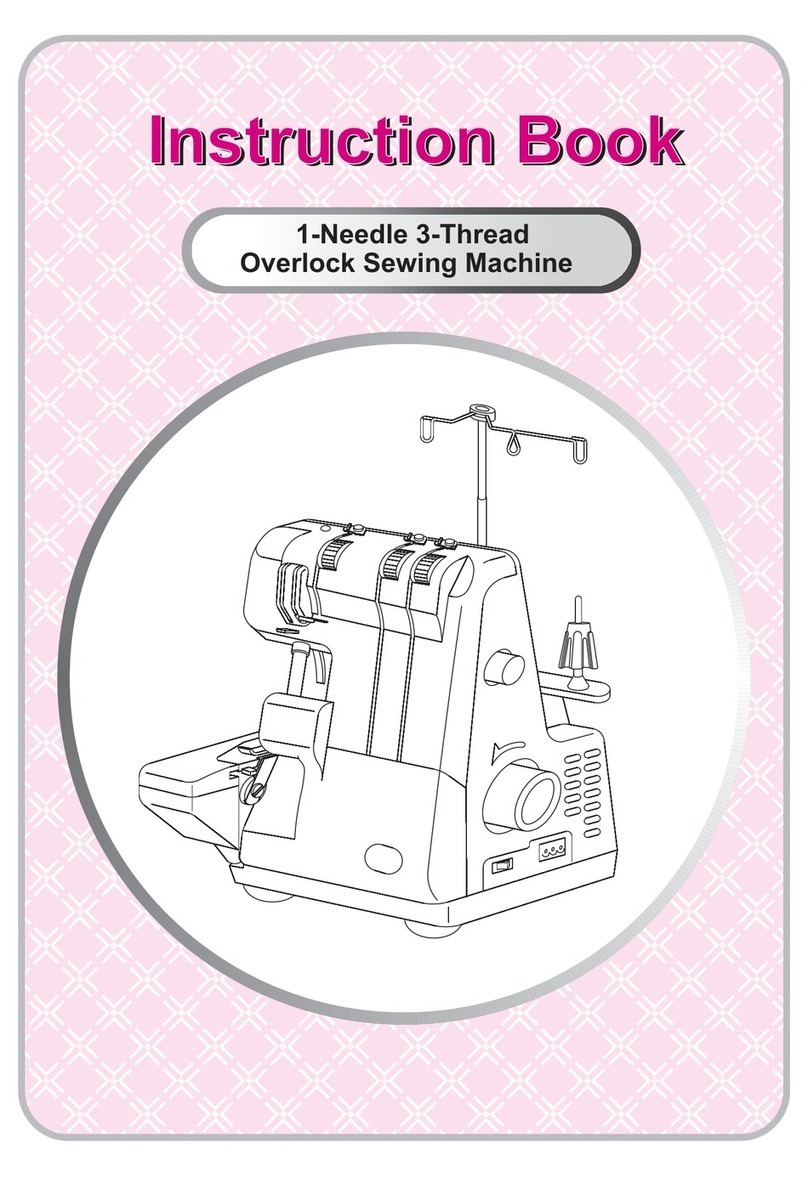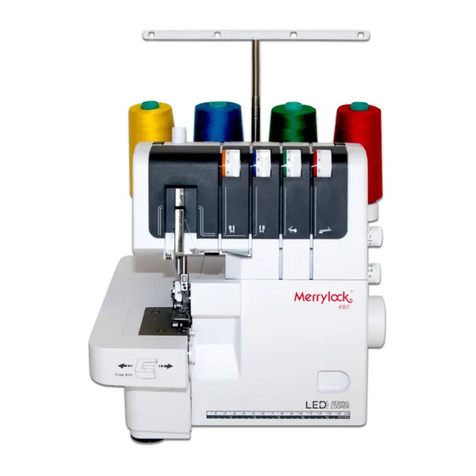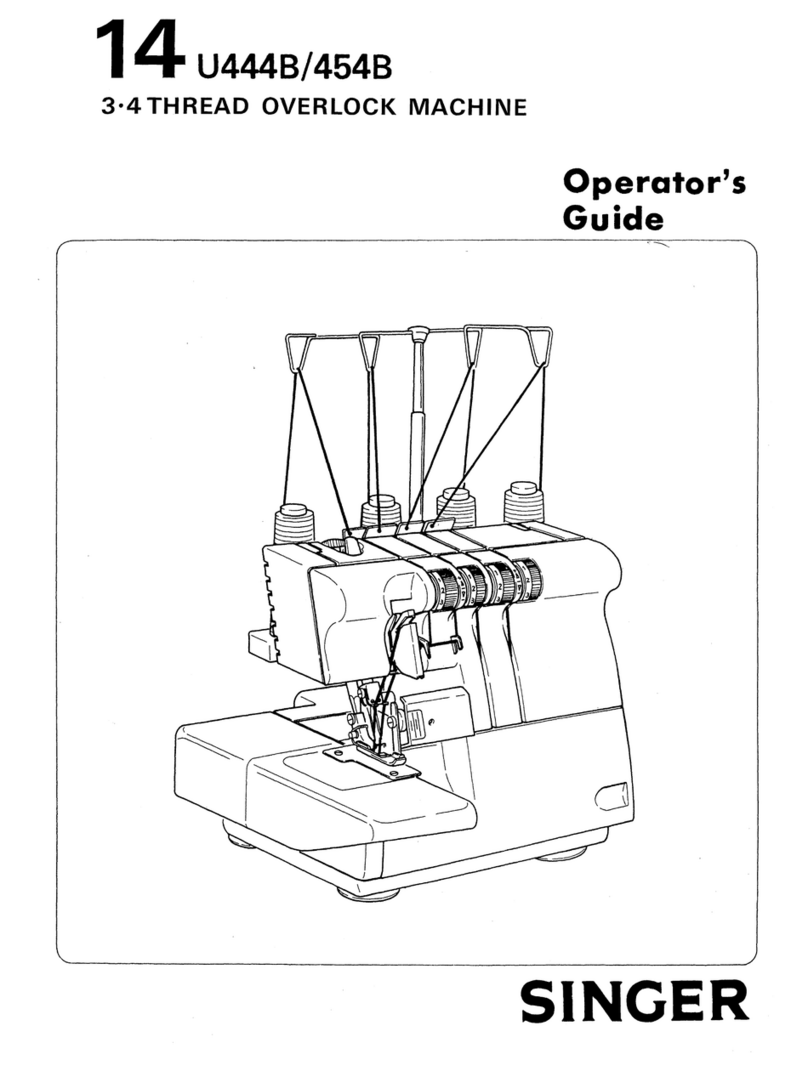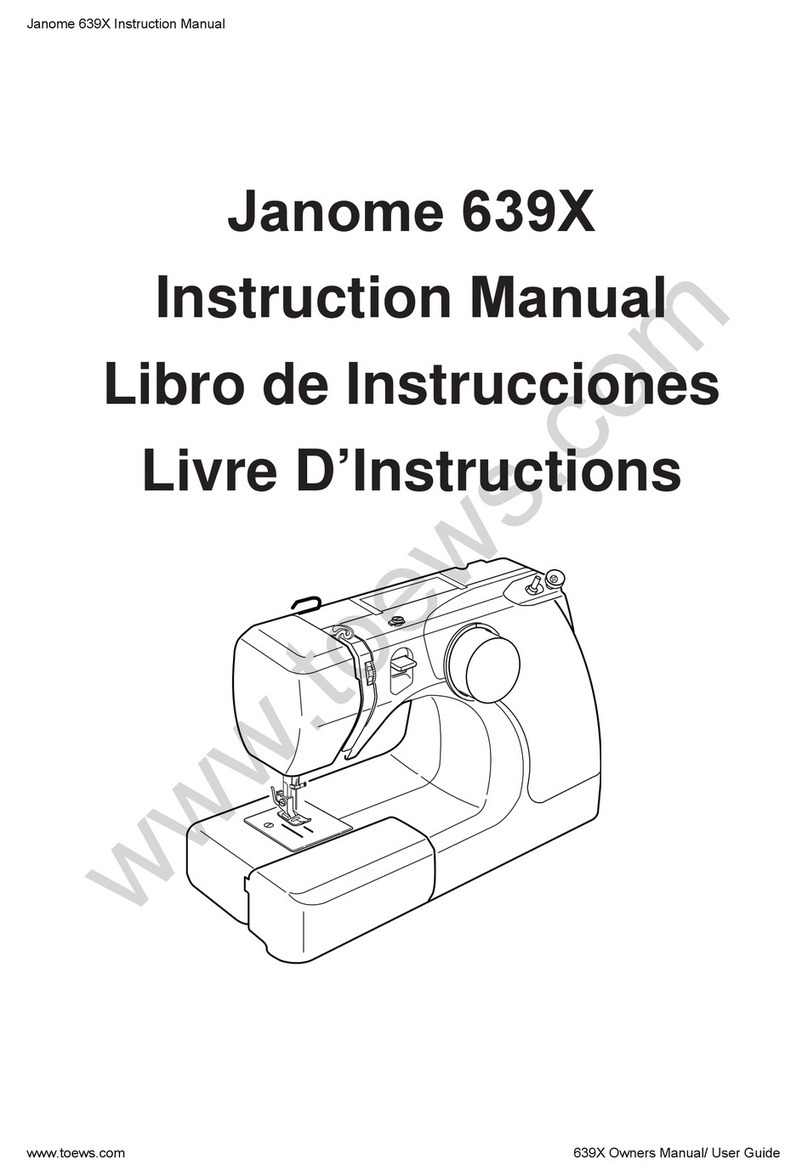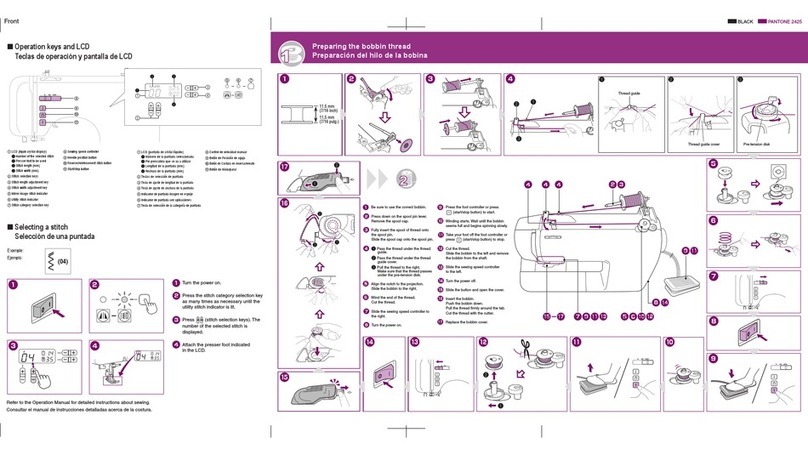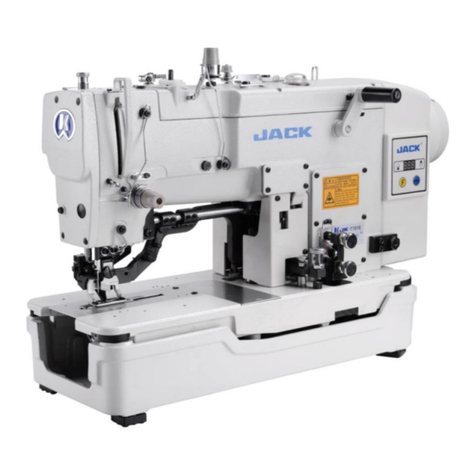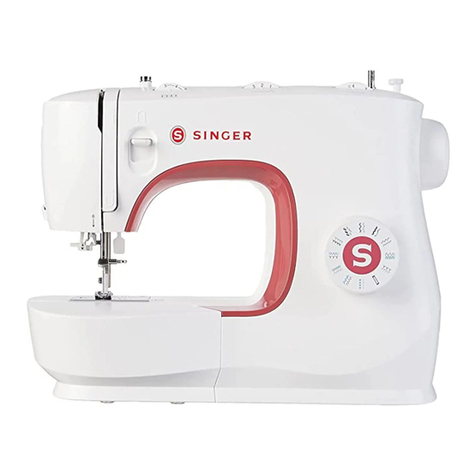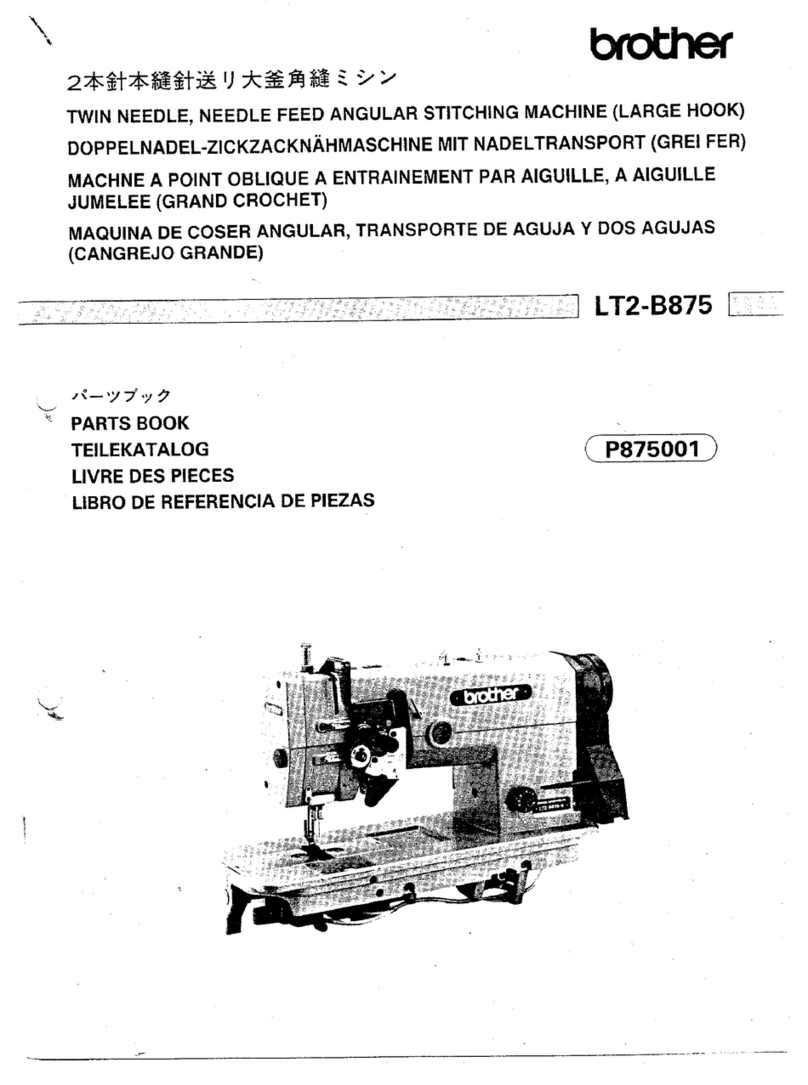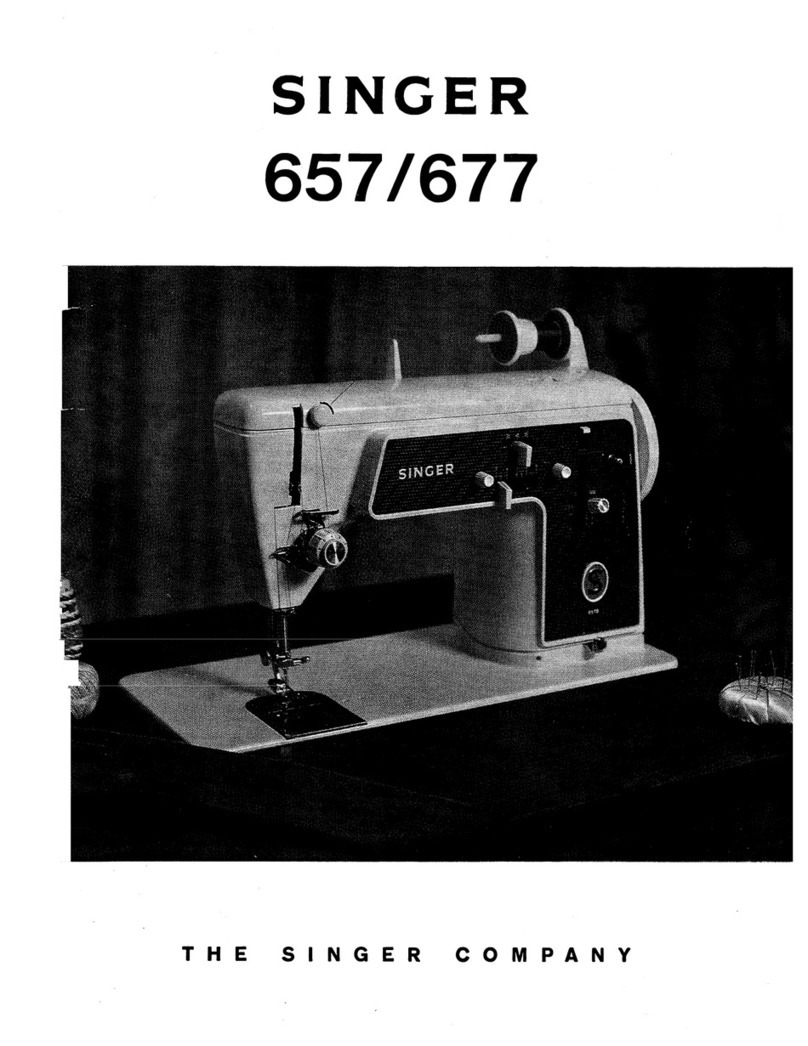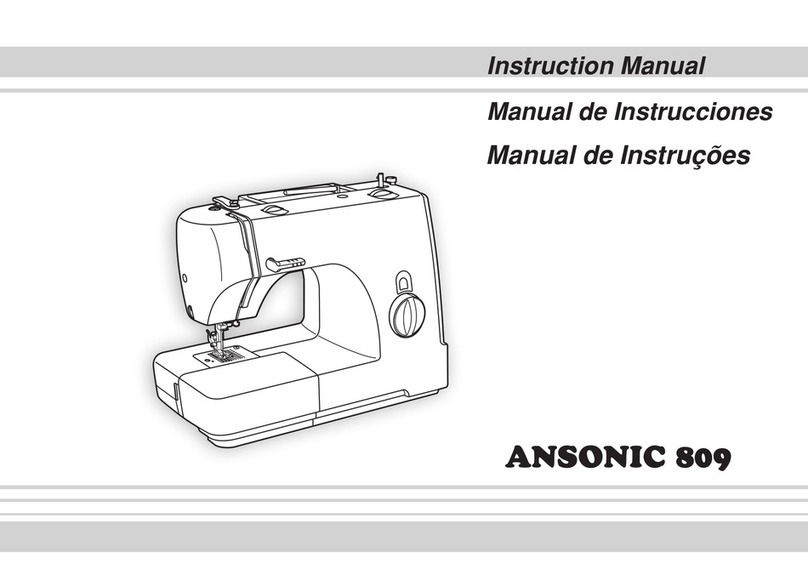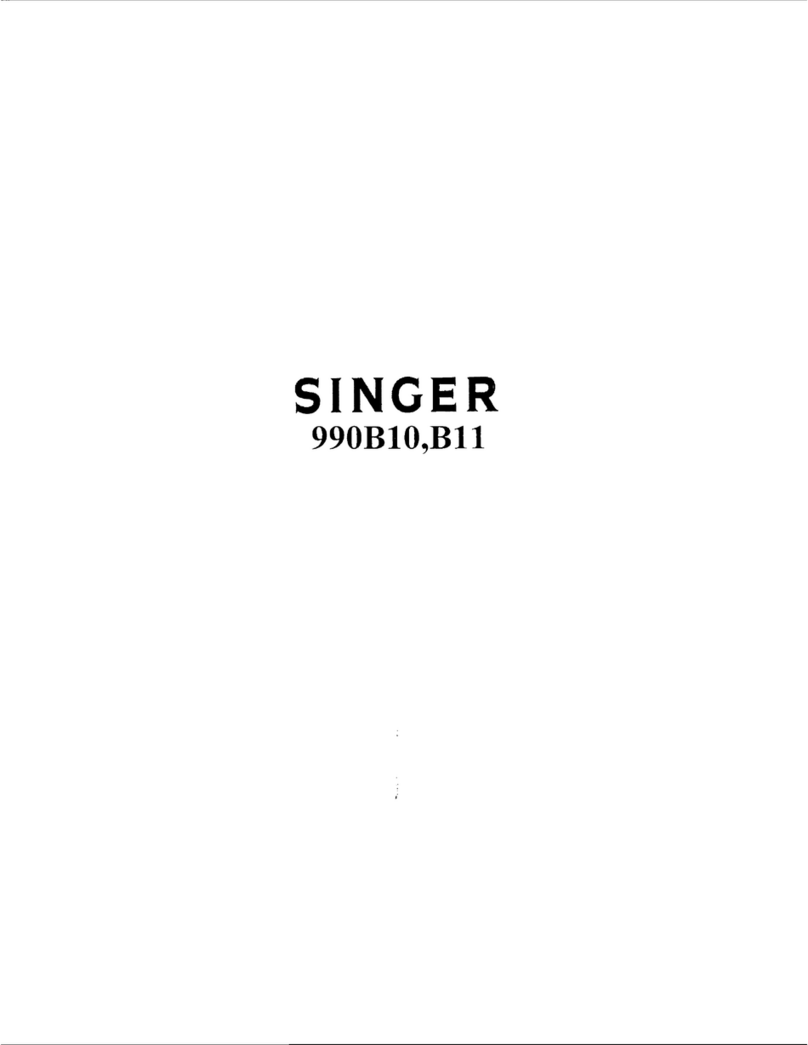Merrylock 2020 User manual

INSTRUCTION BOOK
INSTRUCTION BOOK
INSTRUCTION BOOK

Thank you for your purchase of this Overlock Sewing Machine. This machine, that is intended
for household use will provide you with excellent performance in sewing from light to heavy
material (lawn to denim).
Please refer to this Instruction Book for proper use and optimum service. To get the most out
of your sewing machine, read the entire Instruction Book before attempting to operate the
machine. Then familiarize yourself with the machine by following the Instruction Book page
by page.
To ensure that you are always provided with the most modern sewing capabilities, the
manufacturer reserves the right to change the appearance, design or accessories of this
sewing machine when considered necessary without notification or obligation.
1
PREFACE

When using this machine, basic safety precautions should always be followed including the following.
Read all instructions before using the machine.
* The machine should never be left unattended when plugged in. Always unplug the machine from the
electric outlet immediately after using and before cleaning.
* Always unplug before re-lamping. Replace bulb with the same type rated 15 watts. Be sure to replace the
face plate which covers the light bulb before operating the machine.
* Be sure that the electrical voltage of the electric outlet (wall receptacle) is the same as the rated voltage of
the motor.
* Use this machine only for its intended use as described in this Instruction Book. Use only attachments
recommended by the manufacturer as contained in the Instruction Book.
* To disconnect, turn all controls to the off ("0") position, then remove plug from outlet.
* Disconnect the power line plug from the socket outlet or switch the machine off when making any adjustments
in the needle area, such as threading needle and loopers, changing needle, changing throat plate or changing
presser foot, etc.
* Always unplug the machine from the electrical outlet when removing covers, lubricating, or when making
any other user servicing adjustments mentioned in the Instruction Book.
* Do not attempt to adjust the motor belt. Contact your nearest Service Center should any adjustment be
required.
* Handle the foot controller with care and avoid dropping it on the floor. Be sure not to place anything on top
of the controller.
* Always use the proper throat plate. The wrong plate can cause the needle to break.
* Do not use bent needles.
* When sewing, keep fingers away from all moving parts. Special care is required around the sewing machine
needle.
* Do not pull or push fabric while stitching. It may deflect the needle causing it to break.
* For double insulated machines, when servicing, use only identical replacement parts. See instructions for
Servicing of Double-Insulated Appliances.
* Never operate the machine if it has a damaged cord or plug, if it is not working properly, if it has been
dropped or damaged, or dropped into the water. Return the machine to the nearest authorized dealer or
Service Center for examination, repair, electrical, or mechanical adjustment.
* Never operate the machine with any air openings blocked. Keep ventilation openings of the machine and
foot controller free from the accumulation of lint, dust and loose cloth.
* Never drop or insert any object into any opening.
2
DANGER -To reduce the risk of electric shock:
WARNING -To reduce the risk of burns, fire, electric shock or injury to persons:
IMPORTANT SAFETY INSTRUCTIONS

* Do not use outdoors.
* Do not operate where aerosol (spray) products are being used or where oxygen is being administered.
* Do not allow to be used as a toy. Close attention is necessary when the machine is used by or near
children.
* Do not expose the machine or machine plastic case to sunlight directly. Also, do not keep it in a very warm
or damp place.
* Do not touch the machine, foot controller and power line cord with wet hand, wet cloth or with anything wet.
* Do not connect power line cord to one of the many cords connected to one power outlet with adapters.
* Use machine on flat and stable table.
* Be sure to close the looper cover before operating the machine.
* Keep presser foot and needles away from children's reach.
* Be sure the light bulb has cooled off before changing with a new one.
* Do not dismantle or modify the machine yourself.
* Be sure to turn off the power switch and disconnect the power line plug before caring for your machine as
instructed in the Instruction Book.
* SERVICING OF DOUBLE-INSULATED PRODUCTS. In a double-insulated product, two systems of
insulation is provided instead of grounding. No grounding means is provided on a double-insulated product,
nor should a means for grounding be added to the product. Servicing of a double-insulated product requires,
extreme care and knowledge of the system, and should be done only by qualified service personnel,
Replacement parts for a double-insulated product must be identical to those parts in the product. A double-
Insulated product is marked with the word "DOUBLE-INSULATION" or "DOUBLE-INSULATED".
3

1. .........................................................Principal Parts.
2. ...........................................Accessories...................
3. ..................................................Needle Information.
4. .....................................How to Open Looper Cover
5. ......................Principal Parts Behind Looper Cover.
6. .....................................Preparation prior to sewing.
7. ...........Removal and Replacement of Clean Pocket
8. Preparation prior to sewing......................................
1 . How to Remove and Insert Needles........................
2
*Needle position.........................................................
*To remove needle(s).................................................
*To insert needle(s)....................................................
1 . Threading the Machine...........................................
3
*Threading diagram...................................................
*Understanding the color code..................................
*To thread the machine correctly................................
1) Threading the upper looper (Green)...................
2) Threading the lower looper (Red).......................
4) Threading the overedge left needle (Orange).....
21. .........................Handy Reference Chart..............
22. Suggested Tension Setting..................................
4
Page Page
30
31
31
5
7
7
8
8
8
9
10
10
10
10
11
12
12
12
13
13
13
14
14
16
17
19
20
*Setting up the thread guide holder............................
*Anti-spill net..............................................................
*Spool cap..................................................................
9. How to Disengage Movable Upper Knife................
1 . To Convert upper Looper to 2-thread converter.....
0
*To use the ..................................2-thread converter
*To disengage to upper looper...................................
11. Standard overedge and Rolled Hem Stitching........
*To sew standard overedge........................................
*To sew rolled hem.....................................................
14
14
15
15
15
16
23. How to Sew a Rolled hem...................................
1) 3-thread standard rolled hem stitching..............
2) 3-thread upper looper thread wrapped
rolled hem stitching...........................................
3) 2-thread standard rolled hem stitching..............
4) 2-thread lower looper thread wrapped
rolled hem stitching...........................................
24. Stitch Variations and Sewing Techniques...........
*Decorative Flatlocking...........................................
*How to sew an overlock blind hem........................
*How to sew a pin tucks.........................................
*Turning square corners.........................................
*Pin placement.......................................................
*Securing the thread chain.....................................
25. Machine Maintenance.........................................
*Cleaning the machine...........................................
*Oiling the machine................................................
*How to replace the stationary knife.......................
*How to exchange light bulb...................................
26.Optional Accessories............................................
*Snap-on type presser foot.....................................
*Optional presser feet.............................................
1) Elastic foot........................................................
2) Blind hem foot..................................................
3) Shirring foot......................................................
4) Pearl/Sequin foot..............................................
5) Piping/Cording foot...........................................
6) Taping foot.......................................................
27. Troubleshooting Chart.........................................
28. Relationship between Cloth, Thread and Need...
29. Specification........................................................
37
38
38
39
39
41
42
43
43
44
45
45
46
46
46
47
48
49
49
50
50
50
50
50
50
50
51
52
53
1) 2-Thread Wrapped Edge Overlock....................
2) 2-Thread Overedge...........................................
3) 3-Thread Overlock............................................
4) 3-Thread Flatlock...............................................
5) 3-Thread Ultra Stretch Mock Safety Stitch........
6) 4-thread Ultra Stretch Mock Safely Stitch.........
32
33
34
35
36
1 . How to Change Threads / Tie on Method...............
4
1 . How to Adjust the Stitch length...............................5
1 . How to Adjust the Seam width................................6
*Width adjustment by changing needle position........
*Width adjustment with adjustment knob...................
1 . How to Adjust the Presser Foot Pressure...............
7
1 . Differential Feed......................................................8
*Gathered overedge...................................................
22
23
23
23
23
24
25
25
26
27
28
*Stretch overedge......................................................
19 .... Chaining Off and Test Sewing.............................
. Selection stitches....................................................
20
) Threading the overedge right needle (Blue)........3
TABLE OF CONTENTS

16
2
1
3456
7
8
10
9
11
12
13
14
15
1. Thread guides and holder
2. Handle
3. Left needle thread tension dial (orange)
4. Right needle thread tension dial (blue)
5. Upper looper thread tension dial (green)
6. Lower looper thread tension dial (red)
7. Spool pin
8. Throat plate
9. Cloth plate
10. Looper cover
11. Power & light switch
12. Stitch length dial
13. Hand wheel
14. Spool stand
15. Spool holder
16. Clean pocket
5
1. PRINCIPAL PARTS

17. Presser bar lifter and tension release
18. Differential feed adjusting dial
19. Cutting width dial
20. Foot pressure adjusting dial
20
17
18
19
6

12345
6789
10
11
12
13
Accessories are contained in the accessory case
1. Screw driver (large size)
2. Knife (stationary)
3. Thread Unwinder spool cap
4. Anti-spill net
5. Oiler
6. Allen Screw driver (small)
7. Tweezers
8. Needle set
9. Brush
10. Spool holder
11. Clean pocket
12. Machine cover
This overlock uses a flat shank industrial needle
that eliminates the possibility of inserting the needle
backwards.
Do not attempt to use a standard household sewing
machine needle of any size or type in this overlock.
7
1
1
4
1
1
1
1
1
1
1
1
HAx1 (130/705H)
Overlock needle
4
1.
3 2-thread converter (option) 1
2. ACCESSORIES
3. NEEDLE INFORMATION

ON
OFF
2
1
2
4
3
6
1
5
Caution:
Be sure to turn off power switch.
1 Push the cover to the right as far as it will go.
2 Pull cover down toward you.
8
Caution:
Be sure looper cover is closed when
sewing.
1. Upper looper
2. Moveable Upper knife
3. Presser foot
4. Fixed position lower knife
5. Lower looper
6. Rolled Hem lever
Use only foot controller provided with this machine.
(Type 4C-316B for U.S.A. & CANADA only)
Be sure to make reference to "Warning" on following
Page.
Connect the controller/electric plug to the machine
receptacle.
Plug power line into electric outlet.
Power Switch: Push"l"mark side to turn "ON"
To run the machine and control the speed, press
the controller.
The harder you press, the faster the machine will sew.
To stop the machine from sewing, remove your foot
from the controller.
WARNING:
Push "O" mark side to turn "OFF"
5. PRINCIPAL PARTS BEHIND THE
4. HOW TO OPEN LOOPER COVER
LOOPER COVER
6. PREPARATION PRIOR TO SEWING

1
3
2
This appliance has a polarized plug (one blade wider than the other). To reduce the risk of
electric shock, this plug is intended to fit in a polarized outlet only way. If the plug does
not fit fully in the outlet, reverse the plug. If it still does not fit contact a qualified electrician
to install the proper outlet. Do not modify the plug in any way.
9
Warning:
Insert the clean pocket under the looper cover.
Be sure the left side of clean pocket is mounted near the
cutter where the scraps drop.
* Be sure that the electrical voltage of the electric outlet (wall receptacle) is the same as the rated
voltage of the motor.
* Handle the foot controller with care and avoid dropping it on the floor. Be sure not to place anything
on top of it when not in use.
* Disconnect the power line plug from the electric outlet when changing needles, presser feet
or when leaving the machine unattended. This eliminates the possibility of starting the machine
by accidentally pressing the controller.
Replacement
To remove, hold the clean pocket as shown and
pull it outward.
Removal
POLARIZED PLUG INFORMATION (FOR U.S.A. & CANADA ONLY)
7. REMOVAL AND REPLACEMENT OF
CLEAN POCKET

Anti-spill net
Spool cap
Thread spool
Press in
10
When using synthetic threads that easily spill off
the cone, slip the anti-spill net furnished with the
machine over the thread from the bottom of the
cone leaving the thread end hanging free at the
top the anti-spill net as shown at right.
Take out the thread guide from the top of
Styrofoam, and insert it as shown on the right
illustration.
This machine is shipped with the thread guide
holder on the top of styrofoam.
Fully extend the thread guide holder.
The two joints on the telescope will click into place
when they are correctly positioned.
Center the thread guides above the spool pins.
Place thread over the cone adapters on the spool
pins.
When using a regular thread spool, fit the spool cap
supplied with the machine onto the thread spool as
shown at right.
Setting Up the Thread Guide Holder
8. PREPARATION FOR THREADING
Anti-spill Net
Spool Cap

2
1
2
1
11
Open looper cover (page 8).
Pull the movable knife holder to the right as far as
it will go.
Turn the holder toward counter clockwise until the
knife clicks into a lock position.
Caution:
Be sure to turn off power switch.
Open looper cover.
Pull the movable knife holder to the right as far as
it will go.
Turn the holder clockwise until the knife clicks into the
working position
Caution:
Always close looper cover before operating
machine.
To place movable knife in working position
To place movable knife in nonworking position
9. HOW TO DISENGAGE MOVABLE
UPPER KNIFE

12
To engage the , insert the sharp part into
the
2-thread converter
eye of upper looper.
When not threading the upper looper, the 2-thread converter
must be engaged into the upper looper eye.
When using the upper looper, the must
be
2-thread converter
disengaged.
Caution:
Be sure to turn off power switch
To disengage the 2-thread converter, raise the handle of
upper looper according to picture .
A raised point located in the trough of 2-thread converter
must be inserted and fixed in the eye of the 2-thread
converter.
1
2
3
1
2
3
3
To Use the 2-thread converter
To Disengage to Upper Looper
10. TO CONVERT UPPER LOOPER TO
2-THREAD CONVERTER

R
N
R
N
13
Set seam width finger knob to N to move seam
width finger to standard overedge sewing position.
Set seam width finger knob to R to retract the seam
width finger and set it for rolled hem.
Note: Be sure to push seam width finger knob as far
as it will go in the direction of setting R.
Note: Be sure to push seam width finger knob as
far as it will go in the direction of setting N.
To Sew Rolled Hem
To Sew Standard Overedge
11. STANDARD OVEREDGE AND ROLLED
HEM STITCHING

Turn the hand wheel toward you until the needles are
at their highest position.
Place a thick piece of fabric [such as felt] under the
presser foot. Lower the needles halfway into the
fabric.
Loosen, but do not remove the needle set screws with
the small allen screwdriver. Hold the needles with
your fingers and raise the needle bar. The needles
will remain in the fabric.
A. Overedge needleleft
B. Overedge needleright
With this machines, two needles can be inserted
to the needle clamp as shown in the drawing but only
one or two needles are to be used for sewing.
The Instruction Book refers to different needle
positions by illustrating the needle clamp at right.
Note: When both the left and right overedge needles
are inserted, the left needle will be slightly
higher than the right.
Caution:
Be sure to disconnect the machine from the
electric outlet before removing needle(s).
Hold the needle with the flat surface to the back.
Insert the needle into the needle socket as far as it
will go.
When inserting a needle, if you first lower it down
into the hole in the throat plate it will line up with the
needle socket. Then direct it upwards
Note: When inserting needles into the A or B sockets
it is necessary to loosen both A & B Allen Screws.
After inserting the needles equally tighten both
Screws.
14
Overedge left needle
Overedge right needle
Left and right
overedge needle
thread
B
To loosen
To tighten
Flat surface to the rear
BA
Right overedge
needle thread
To Insert Needles (s)
12. HOW TO REMOVE AND INSERT
NEEDLES
Needle Position
To Remove Needle (s)
B
A
AB

4312
15
A color coded threading diagram is located inside
the looper cover for quick reference.
Thread the machine in the order 1 to 4 as shown
at right.
Note: Threads go through the take-up lever cover
for Overlock as shown.
1. Upper looper thread............................
2. Lower looper thread............................
3. Left needle thread...............................
4. Right needle thread.............................
Green
Red
Orange
Blue Left needle thread
Right Needle thread
Upper looper thread
Topside
Lower looper thread
Underside
13. THREADING THE MACHINE
Threading Diagram: Overlock and Safety Stitches
Tension Color Code: Overlock and Safety Stitch

To Thread The Machine Correctly
1) Threading the (Green)Upper Looper
16
Caution:
Be sure to turn off power switch.
Thread the top cover
thread guide by pulling
the thread towards the
left until it slips under
guide. Then pull
thread along the right
side of button as
illustrated.
While holding thread with fingers, pass it between
the tension discs and pull thread down to make
certain it is properly located in between the
tension discs 3.
Thread the upper looper as indicated 1~9.
Pass thread from back to the front through the
thread guide 1.
Raise Presser foot to release tension discs.
2
4
3
33
2
2
4
7
6
9
8
2
5
3
1
1

2) Threading the (Red)Lower Looper
17
Thread the top cover
thread guide by pulling
the thread towards the
left until it slips under
guide. Then pull thread
along the right side of
button as illustrated.
Thread the lower looper as indicated 1~10.
Thread the looper area of the machine following the
green color coded thread guides (4~9).
Thread the hole in the upper looper from front to
back 9. Note: Make sure thread passes behind lower
looper.
Note: Use tweezers provided in the accessory
case to aid in threading the looper.
Pull about 10cm(4 inches) of thread through the
looper and place to the back of the throat plate.
Pass thread from back to the front through the
thread guide 1.
Raise Presser foot to release Tension discs
10cm
(4")
2
2
9
8
9
5
4
8
6
7
7
9
6
5
8
4
2
3
1
10
1

10cm
(4")
18
Thread the looper eye (A) from front to back.
Pull about 10cm (4 inches) of thread.
Position thread into V cutout (B) on threader.
Firmly hold thread tail with left hand and pull
Threader lever (C) up into place (D).
Turn the hand wheel toward you until the lower
looper extends out 5~10mm from the throat
plate edge.
Thread the looper area of the machine following
the red color coded thread guides 4~10.
Note: Use tweezers provided in the accessory
case to aid in threading the looper.
While holding thread with finger, pass it between
the tension discs and pull thread down to make
certain it is properly located in between the
tension discs 3.
Place the thread with the point of the tweezers
slightly from left and to the right of threading guide 4.
Place the thread with the point of the tweezers
slightly from front and to the back of threading guide 5.
4
3
2
10
9
9
D
B
A
10
C
4
5
6
7
8
5
3
4
3
8
6
7

19
Pass thread from back to the front through the
thread guide 1.
While holding thread with finger, pass it between
the tension discs and pull thread down to make
certain it is properly located in between the
tension discs 3.
Thread the top cover
thread guide by pulling
the thread towards the
left until it slips under
guide. Then pull thread
along the right side of
button as illustrated.
Thread the right needle as indicated 1~9.
Raise Presser foot to release Tension discs.
4
3
2
3
2
7
5
6
3
2
1
4
3
2
1
3) Threading the (Blue)Overedge Right Needle
(B on needle clamp)
9
8
Table of contents
Other Merrylock Sewing Machine manuals
Popular Sewing Machine manuals by other brands
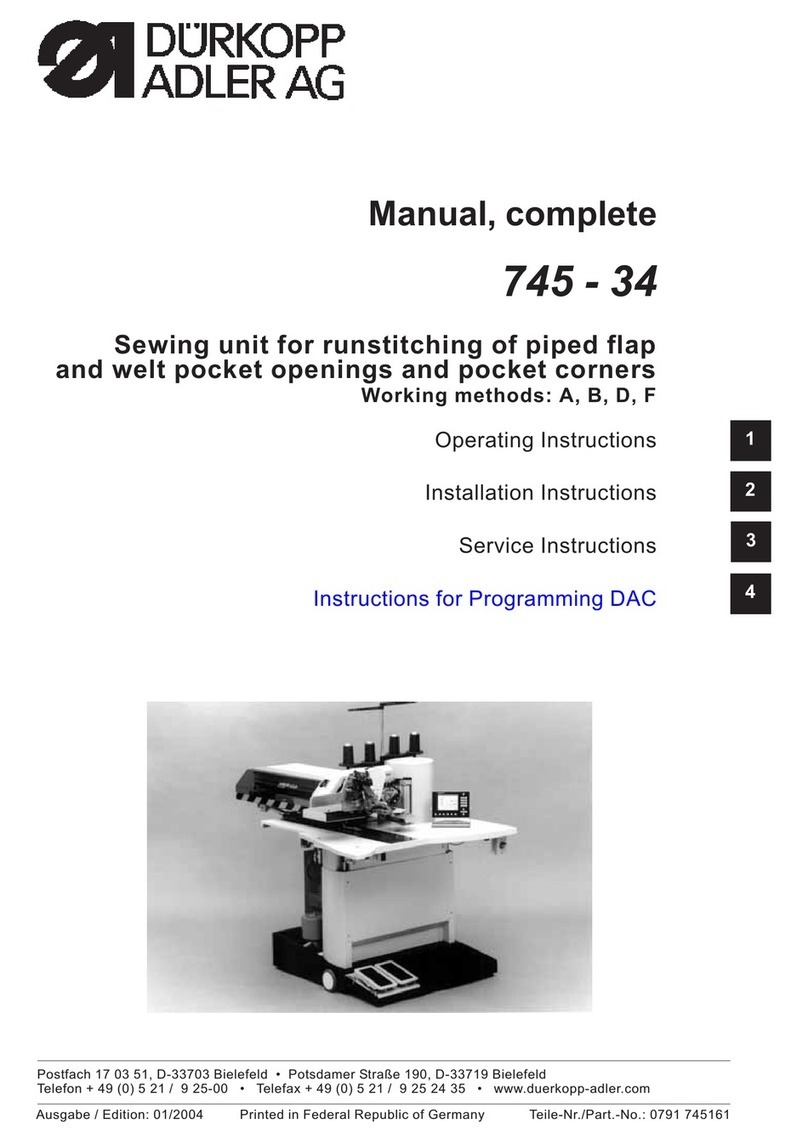
DURKOPP ADLER
DURKOPP ADLER 745-34 - manual
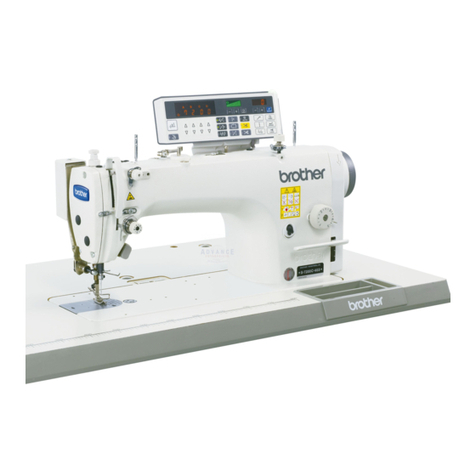
Brother
Brother S-7200B Specifications
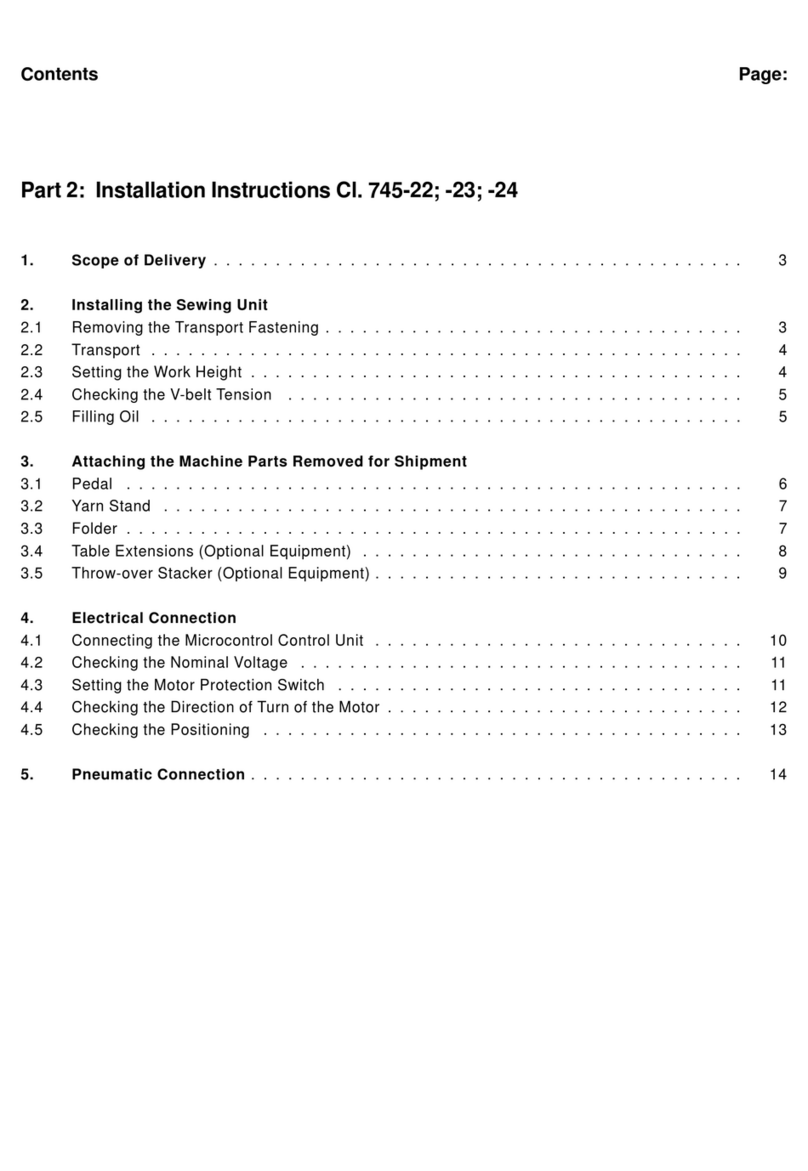
Duerkopp Adler
Duerkopp Adler 745-22 Installation instructions & replacement parts list

Brother
Brother JX2517 Operation manual

Consew
Consew P1255RBL-18 operation instruction
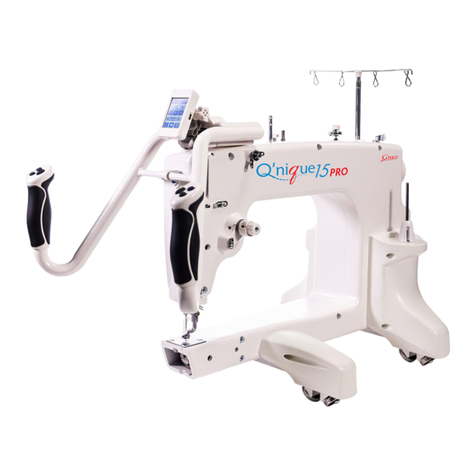
Grace Company
Grace Company G Series instruction manual
